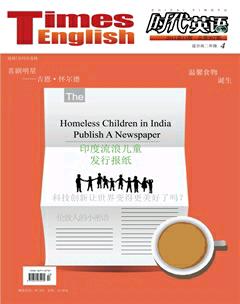印度流浪儿童发行报纸
A group of homeless children in the Indian capital of New Delhi publish a newspaper telling about their own lives.
It is called Balaknama, which means "children's voice". It is written and edited by children up to 19 years old. About 10,000 people read it.
The children write about poverty, child labor, underage marriages, sexual abuse and drugs. A homeless girl named Shanno helps edit the paper.
"When reports arrive and the team sits down to select the story, lots of fights break out. They argue: ‘This story will have more impact than that story.' So there's a lot of debate before the final selection goes to print."
The newspaper has 70 reporters in several states and 14 in the capital. All of the reporters, editors and managers are homeless children.
Jyoti Kumari is one of the reporters.
"I used to beg, do drugs and sometimes go rag picking. Then I learned about Balaknama and began to work for it. First, I was a junior reporter, then a reporter and now I'm all set to become the editor."
Many of their parents are jobless and cannot read or write.
The children now earn money, and many of them attend classes online that may help them find a job.
The newspaper is published every month. It has eight pages. In 2002, when it began operations, the newspaper was published four times a year. It has changed the lives of many of the children who publish it, and hopes to improve the lives of thousands of others.
Non-governmental organizations and charity groups support the newspaper.
Sanjay Gupta leads a group that helps the children and gives money to the newspaper.
"They feel very empowered and encouraged when people appreciate them, and when they talk to the authorities with the confidence, and also before the media. I think this is a really powerful tool to empower them."
The newspaper costs about three cents. That is less than the price of a small cup of tea in India. But the small cost gives the children hope that they will someday have a home and a job.
印度首都新德里一群无家可归的儿童发行了一份报纸,讲述他们自己的生活。
这份报纸名叫Balaknama,意为“儿童之声”。报纸内容由19岁以下的儿童撰写和编辑。大约有1万名读者。
这些儿童撰写关于贫困、童工、未成年婚姻、性虐待和吸毒等问题。一位名叫Shanno的无家可归女孩帮助编辑报纸。
“当报道不断抵达,编辑小组坐下来选择故事,会发生许多争论。他们争论:‘这个故事比那个故事更有影响力。所以,最终付诸印刷之前会发生许多争论。”
这份报纸在几个州共有70名小记者,在首都有14名小记者。所有记者、编辑和管理人员都是无家可归的儿童。
乔蒂·库玛莉就是其中一名记者。
“我过去乞讨、贩毒,有时捡破烂。然后我了解到Balaknama,然后开始为它工作。首先,我是初级记者,随后成为正式记者,现在快要成为编辑了。”
他们中许多人的父母没有工作,不会读写。
这些儿童現在能够赚钱,其中许多人参加网上课程,帮助他们找到一份工作。
这份报纸每个月发行,共有八页。2002年,报纸刚刚开始发行时,每年出版四次。这份报纸改变了许多出版报纸的儿童的生活,同时希望改善数千名其他儿童的生活。
非政府组织和慈善团体支持这份报纸。
桑基·古普塔领导的团体帮助这些儿童,为这份报纸提供资金。
“当人们赞赏他们的时候,当他们充满信心地和当局对话,当他们出现在媒体面前,他们觉得非常有动力,非常受鼓舞。我认为这是鼓舞他们非常有力的工具。”
这份报纸价格为3美分,低于印度一小杯茶的价格。但是这点微不足道的成本却给这些儿童带来希望,他们总有一天能有一个家,有一份工作。

